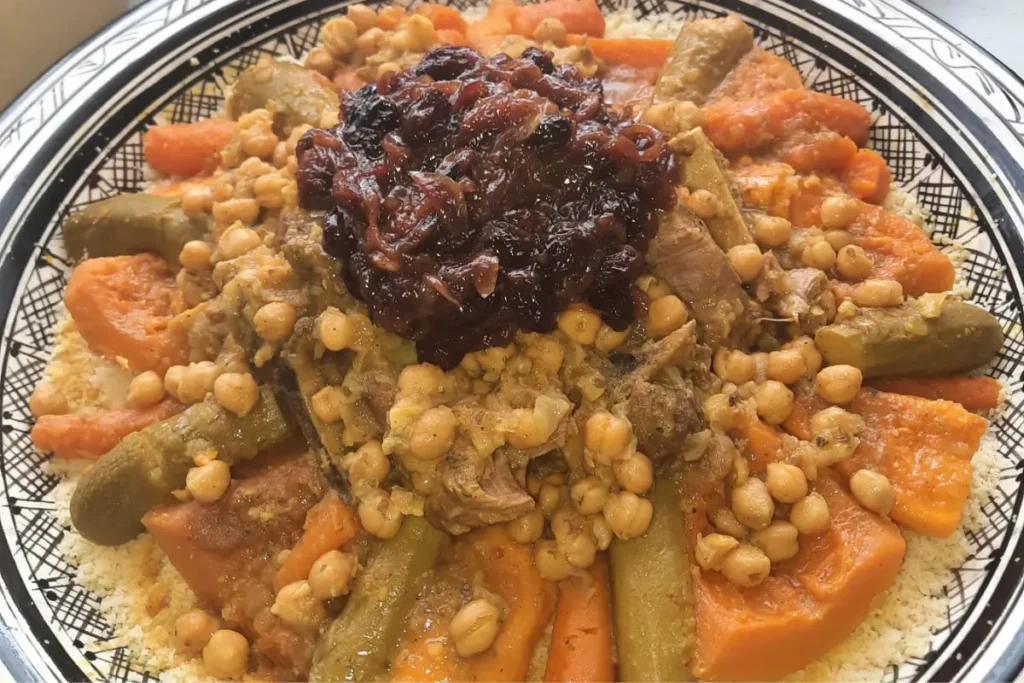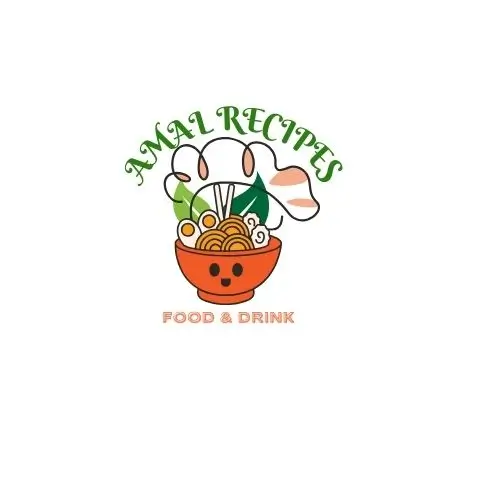Moroccan Couscous: The Heart of North African Cuisine
Moroccan couscous is more than a dish—it’s a cultural symbol, a family tradition, and an explosion of flavors. If you’ve been curious about how to cook Moroccan couscous or the rich heritage behind it, this guide will walk you through everything. From its history to step-by-step preparation tips, you’ll discover why couscous is the crown jewel of North African kitchens.
Table of Contents
What is Couscous?
At its core, Moroccan couscous is semolina wheat granules steamed to perfection. While it might resemble rice or grains at first glance, couscous is technically a type of pasta. But its beauty lies in how it acts as a blank canvas, soaking up the spices, broths, and sauces that accompany it.
Why Should You Try Moroccan Couscous?
- Nutritional Value: Low in fat and a good source of selenium.
- Versatility: Works as a base for stews, salads, or standalone meals.
- Ease of Cooking: Quick to prepare, especially the instant version.
A Brief History of Couscous
Couscous dates back centuries, with its origins rooted in North Africa. Moroccan households have preserved the tradition of preparing couscous as a communal meal, often served on Fridays or during family celebrations.
The dish’s global popularity skyrocketed as traders introduced it to Europe and the Middle East. Today, you’ll find couscous gracing menus worldwide, from fine dining establishments to humble home kitchens.
Different Types of Couscous
When exploring couscous, you might encounter several varieties:
- Moroccan Couscous: Tiny granules that cook quickly.
- Israeli Couscous (Pearl Couscous): Larger, with a chewy texture.
- Lebanese Couscous (Moghrabieh): The largest of the three, used in hearty stews.
For authentic Moroccan flavor, stick to the traditional fine-grain version, steamed multiple times for fluffiness.
How to Cook Moroccan Couscous
You don’t need to be a culinary expert to prepare authentic Moroccan couscous. Follow these simple steps:
Ingredients:
- 1 cup Moroccan couscous
- 1 cup boiling water or broth
- 2 tbsp olive oil or butter
- Salt to taste
Instructions:
- Place couscous in a large bowl.
- Drizzle olive oil or melted butter over it and mix well.
- Pour boiling water or broth over the couscous and cover.
- Let it sit for 5 minutes, then fluff with a fork.
For traditional preparation, use a couscoussier (a special steamer) to steam the couscous three times, adding flavor with each round.
Perfect Pairings for Moroccan Couscous
Couscous truly shines when paired with hearty dishes and bold spices. Here’s how you can elevate your meals:
Main Course Pairings:
- Vegetable Tagine: A medley of carrots, zucchini, and chickpeas simmered in Moroccan spices.
- Chicken with Preserved Lemons: A savory-sour combination that complements couscous beautifully.
- Lamb Stew with Apricots: Perfect for special occasions, this dish balances sweetness and spice.
Salads:
Transform couscous into a refreshing salad with fresh herbs, lemon juice, and diced vegetables.
Soups:
Add cooked couscous to soups for a filling, wholesome meal.
Spice it Up: Moroccan Flavors for Couscous
Moroccan cuisine is renowned for its bold and aromatic spices. Here’s how you can season couscous like a pro:
- Ras el Hanout: A blend of cinnamon, cumin, and coriander.
- Saffron: Adds a luxurious aroma and golden hue.
- Paprika and Cayenne: For those who like a little heat.
You can also experiment with fresh parsley, cilantro, and mint for a burst of freshness.
Nutritional Benefits of Moroccan Couscous
Couscous is not just delicious—it’s also packed with nutrients that support your overall well-being:
- Low in Fat: Perfect for a heart-healthy diet.
- High in Fiber: Aids digestion and keeps you full longer.
- Rich in Selenium: An antioxidant that protects your cells and boosts immunity.
However, if you’re gluten-sensitive, couscous may not be the best choice, as it’s made from wheat.
Couscous recipes
Here’s a collection of creative and flavorful couscous recipes that showcase its versatility, perfect for any meal:
1. Moroccan Lamb Stew with Couscous

This rich, aromatic one-pot meal pairs tender lamb with vegetables and a blend of sweet and savory spices, offering a perfect balance of flavors for special occasions or cozy dinners.
2. Harissa Lime Chicken Couscous Skillet
A quick, spicy, and zesty one-pan meal featuring juicy chicken and couscous, ideal for weeknights or entertaining guests.
3. Couscous with Tomatoes and Olives
This Mediterranean-inspired dish combines Israeli couscous with juicy tomatoes, briny olives, and fresh herbs, making it a great side for grilled meats.
4. Shrimp and Couscous Foil Packets
A light yet flavorful dish with shrimp, couscous, and avocado-mango salsa, perfect for grilling or baking with easy cleanup.
5. Lemon-Basil Grilled Shrimp with Couscous
This recipe combines tender grilled shrimp with herby lemon couscous for a fresh, summery main course.
6. Couscous-Stuffed Eggplant
Eggplants are roasted and filled with spiced couscous, vegetables, and herbs, creating a healthy, flavorful vegetarian dish.
7. Cranberry-Orange Couscous Salad
A refreshing salad with dried cranberries, orange zest, and a hint of fennel, this dish is a vibrant choice for light meals or potlucks.
8. Mexican Couscous
Infused with classic Mexican flavors, this quick one-pot meal is versatile as a side or main dish for taco nights.
9. Masala Couscous Pulao
A fusion dish where couscous meets Indian spices, mixed with fresh vegetables for a bold and aromatic meal.
10. Vegetable Couscous
A hearty and healthy option, combining roasted or steamed vegetables with couscous, perfect as a main or side dish.
These recipes reflect couscous’s ability to absorb diverse flavors, making it a perfect base for salads, side dishes, or hearty mains. You can explore more ideas and inspiration for couscous dishes for detailed instructions and additional recipes.
Couscous salad
Here are two delightful couscous salad recipes that are easy to prepare and brimming with fresh flavors. They make a perfect side dish or a light meal.
1. Mediterranean Couscous Salad
This vibrant salad combines couscous with fresh vegetables and tangy feta cheese, tossed in a lemony dressing:
- Ingredients: Moroccan couscous, grape tomatoes, cucumbers, red onion, fresh parsley, mint, feta cheese, olive oil, lemon juice, and garlic.
- Steps: Cook the couscous by letting it soak in boiled water. Once cooled, toss it with chopped vegetables, herbs, and crumbled feta. Prepare a simple dressing with olive oil, lemon juice, and garlic, then mix it all together. You can add toasted almonds for an extra crunch.
- Variations: Add chickpeas for protein or experiment with herbs like basil or dill instead of mint. You could also swap feta for goat cheese or cotija for a new flavor
2. Sun-Dried Tomato and Chickpea Couscous Salad
This is a quick, hearty salad featuring sun-dried tomatoes and chickpeas:
- Ingredients: Couscous, chickpeas, sun-dried tomatoes in oil, fresh parsley, rocket/arugula, feta cheese, lemon zest, and juice.
- Steps: Combine couscous with chickpeas and soak in vegetable stock for added flavor. After cooling, toss with sun-dried tomatoes (and their oil), herbs, rocket, and lemon. Finish with crumbled feta and adjust seasoning.
- Tip: This salad is perfect for meal prep as it keeps well for a couple of days in the refrigerator
Frequently Asked Questions
Is Moroccan couscous gluten-free?
No, couscous is made from semolina, which contains gluten.
Can you freeze cooked couscous?
Absolutely. Store it in an airtight container and freeze for up to 3 months.
What’s the difference between couscous and rice?
While they may look similar, couscous is pasta, and rice is a grain. Couscous cooks faster and absorbs flavors more easily.
Is couscous healthy?
Couscous can be a healthy option, depending on how it’s prepared and the context of your overall diet. Here are some key factors to consider:
1. Nutritional Content
Low in Calories: Couscous is relatively low in calories, which makes it a good choice for those looking to manage their weight.
Carbohydrates: It is primarily composed of carbohydrates, which provide a good source of energy.
Fiber: Whole wheat couscous, in particular, contains more fiber than the regular kind. Fiber supports digestive health and helps with satiety (feeling full).
Protein: Couscous contains some protein, though not as much as other grains like quinoa or legumes. You can boost protein by pairing couscous with protein-rich foods such as beans, chicken.
Ready to Master Moroccan Couscous?
It’s time to bring the warmth and spice of Morocco into your kitchen. Whether you’re hosting a dinner party or craving comfort food, couscous is your answer. Try out a recipe today and elevate your culinary game.
Let us know in the comments how your couscous dish turned out, or share your favorite recipes. And if you’re ready for more, explore our detailed guides on Middle Eastern cuisine.

